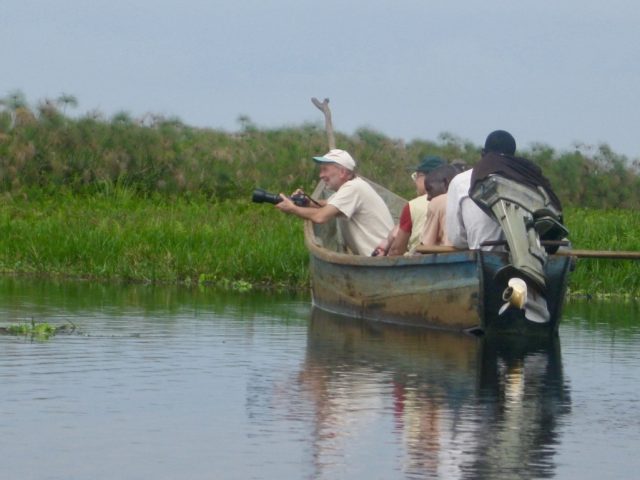This Uganda`s best area for tracking the majestic shoebill stork bird in Uganda. You can access this area by using the Entebbe Nakawuka road. Generally, Mabamba Swamp is located on the Northern shores of Lake Victoria. This is a prime wetland area with wonderful biodiversity and significant bird life. It is also located 50 Kilometers west of Kampala capital city of Uganda and it stretches along the lake making it an integral part of the larger Lake Victoria basin. This beautiful marshland can also be accessed from Nakiwoggo landing site via boat. Mabamba swamp is known for its significant shoebill stork which has attracted many of the bird watchers and other international travelers across the globe to come and carry out birding as well as track the shoe bill. Mabamba swamp is located in the Tropical climate zone has supported the existence of swamp which is has become a habitat for many other species of birds, reptiles and the shoebill stork. Many people have visited this area because it is easily accessible by many people from Entebbe and from Kampala

History of Mabamba Swamp in Uganda
This wetland which falls within the larger Lake Victoria has been key source of water for the people living within the catchment area for generations. The swamp has been exploited majorly for food and income since the area is fertile for agriculture and fishery due to the presence of fish in the swamp. The very name Mabamba has been derived from the Luganda language so that it also takes into cognizance the cultural affiliation of the people to the swamp. In earlier times, Mabamba Swamp was not so famous among the global communities but was discovered at the end of the 20th century when bird watch and conservationists discovered the value of the swamp. Due to the factors of this swamp where there are pan of papyrus and channels of water it favors many forms of birds most favorable of all is the Shoebill Stork. This dinosaur like bird with big beak drew a lot of tourists and researchers to this area owing to its rare look. By the time bird watching was becoming popular around the world Mabamba Swamp became one of the many destinations renowned for Shoebill’s natural habitat. This changed situation has created some positive impacts and also negative impacts to the area.
It is noteworthy that the conservation activities in Mabamba Swamp became much more active in the early 2000’s. Starting from Nature Uganda and going up to the Mabamba Wetland Eco-Tourism Association (MWETA), these companies also strived to conserve the swamp and its unique flora and fauna while at the same time trying to push for the establishment of eco-tourism in the region. Measures that were undertaken in this regard included carrying out awareness campaigns and sensitization of the communities to embrace and protect their ecosystem, and diversifying income sources through tourism. Specifically, people’s participation was essential in preserving these species and their ecosystems because the locals knew how to preserve the swamp’s equilibrium. Here’s the thing; the swamp has more uses to ecological succession than only the bird aviary. It helps in filtering water before the water flows into Lake Victoria an important resource for millions of people. Also, the activities and cooperative processes that occur in the swamp also control climate change, and it is a home for various fish and plant species.
The Experience of Tracking shoebill storks in Mabamba Swamp

The tracking of these bird species resembling those of the pre-historic age is an exciting adventure that involves the core of exploration while surrounded by the magnificence of one of Africa’s best preserved swamp systems. The day starts early in the morning and the most preferred time to spot the shoebills is in the morning, preferably at dawn. Standing in the shallow water and reeds early in the morning, when the sun is rising and providing golden light to the swamp, people get anxious. The invasion into the swamp is normally done in small canoes with the help of indigenous persons who are conversant with the tortuous passages of the swamp. These are not only good boat operators but equally good at bird watching and can spot all the different birds that are found in Mabamba. Paddling gently through the shallow and murky water the thick vegetation such as papyrus and other floating plants open up to show a whole new world. There are flights of egrets and kingfishers and herons gliding low over the reeds and the sedges; and there is a shrill concert of the songs of countless other birds.
The most memorable and perhaps most distinctive of these birds is the shoebill stork with its other worldly looking beak, or bill. It measures standing between 5 and 24 inches tall with a huge shoe-like bill, this rump is certainly one to marvel at. Sighting of one in the wild truly I would use the word is an exhilarating experience. The guides are fully aware of the locations to take the visitors most of the time taking them to areas the shoebills are known to breed or feed in. These are poster birds of ‘fishing’ and are able to wait for long periods as they watch for their prey; in this case fish. This action means bird watchers and photographers can easily observe and photograph these marvelous birds in their natural environment. Bird watching of shoebill storks in Mabamba Swamp is not only the storks but also the environment of the swamp. It affords one an opportunity to marvel at the fine equilibrium that supports this type of wetland.
Conclusion
They are many areas where you can see the might shoe bill stork in Uganda today. When you visit Uganda, you will best track the shoebill stork from Mabamba Swamp which is located in Entebbe. The shoebill stork is a migratory bird which moves from one wetland ecosystem to another. Other areas to see the shoebill stork is in Murchison Falls National Park, Queen Elizabeth National park and other wetland ecosystems to find in Uganda. It is recommended to choose a wonderful and the best tour operator to ensure that they plan for you a wonderful shoe bill safari in Uganda today.
